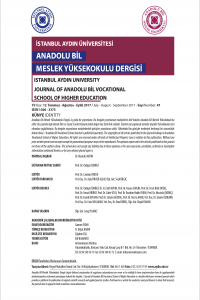Otomotiv haberleşmesinde denetleyici alan ağı için hibrit bir saldırı savuşturma uygulaması
Teknoloji geliştikçe insanların yaşam kalitesinden beklentileri de her geçen gün artmaktadır. İnsanlar her alanda olduğu gibi otomotiv alanında da kaliteli yaşam sürmek istemektedir. Otomotiv teknolojisi insanların yaşam kalitesini artırmak için teknolojisini her gün geliştirmektedir. Otomotiv teknolojisi geliştikçe araç içerisinde insanların isteklerini yerine getiren birimlerin, elektronik kontrol ünitelerinin (ECU) sayısı da her geçen gün artmaktadır. Araç içerisinde insanların isteklerine cevap veren elektronik kontrol ünitelerinin, haberleşmesinde gerçek zamanlı performansı ve verimli iletişiminden dolayı yaygın olarak denetleyici alan ağı (CAN) kullanılır. Ancak CAN haberleşmesinin ağ güvenliğinin nasıl sağlanacağı tartışmaları son zamanlarda oldukça artmıştır. Araştırmalara göre kontrolü basit ve doğası gereği güvenlik açığı olan bu haberleşme ağının kontrolü otomotiv korsanları tarafından kolayca ele geçirilebilir. Araç içerisinde CAN haberleşme ağına sızan korsanlar elektronik kontrol ünitelerini uzaktan kontrol ederek sadece araca değil insan sağlığına da etkilerinin olduğu yine araştırmalarda görülmüştür. Otomotiv teknolojisi gelişirken ortaya çıkan güvenlik açıklarına karşı sessiz kalmayan araştırmacılar alınması gereken önlemleri kendi makalelerinde işlemiştir. Bu araştırmanın amacı, araç içi haberleşme ağında korsan belirleme ünitesi (KBÜ) kurularak korsan varlığı belirlenip elektronik kontrol ünitelerinin birden fazla yoldan basit şifreli haberleşmesi sağlanarak saldırıları savuşturmaktır.
Anahtar Kelimeler:
Denetleyici alan ağı, şifreli haberleşme, korsan belirleme ünitesi, araçta ağ güvenliği, otomotiv saldırı tespiti
Hybrid attack avoidance application for the controller area network in automotive communications
As technology develops rapidly, people are usually expected to increase their life quality day by day, especially in automotive sector. As the automotive technology develops, the number of units, electronic control units (ECU) that fulfil the wishes of the people in the vehicle is increasing as day pass. The controller area network (CAN) is widely used due to the real-time performance and efficient communication of electronic control units that respond to the requests of the people in their vehicle. However, discussions on how to secure the network of CAN communication have increased recently. According to research, the control of this communication network, which is simple to control and vulnerable in nature, can be easily taken over by automotive hackers. It has been seen in the researches that the hackers who infiltrated the CAN communication network in the vehicle have effects not only on the vehicle but also on human health by remotely controlling the electronic control units. The researchers, who did not remain silent against the security gaps that emerged as automotive technology developed, covered the precautions that should be taken in their articles. The aim of this research is to defend the attacks by establishing a hacker detection unit (KBU) in the in-vehicle communication network and determining the presence of hacker and providing simple encrypted communication of electronic control units in multiple ways.
Keywords:
Controller area network, encrypted communication, hacker identification unit, in vehicle network security, automotive intrusion detection,
___
- Boudguiga, A. Klaudel, W. Boulanger, A. ve Chiron, P. (2016). A Simple Intrusion Detection Method for Controller Area Network, 2016 IEEE International Conference on Communications (ICC)
- Bozdal, M. Samie, M. ve Jennions, J. (2018). A Survey on CAN Bus Protocol: Attacks, Challenges, and Potential Solutions, 2018 International Conference on Computing, Electronics & Communications Engineering
- Bulck, J.V. Muhlberg, J.T. ve Piessens, F. (2017).VulCAN: Efficient Component Authentication and Software Isolation for Automotive Control Networks, ACSAC 2017
- Diffie, W. ve Hellmann, M.E. (1979). Privacy and Authentication: A Introduction to Cryptography, Proceedings of the IEEE
- Gmiden, M. Gmiden, M. H. ve Trabelsi, H. (2019). Cryptographic and Intrusion Detection System for automotive CAN bus Survey and contributions, 2019 16th International Multi-Conference on Systems, Signals & Devices (SSD).
- Groza, B. Murvay, S. Herrewege, A. V. ve Varbeuwhede, I. (2012). LiBrA-CAN: A Lightweight Broadcast Authentication Protocol for Controller Area Networks, International Conference on Cryptology and Network Security.
- Koscher, K. Czeskıs, A. Roesner, F. Patel, S. Kohno, T. Checkoway, S. Mccoy, D. Kantor, B. Anderson, D. Shacham, H. ve Savage, S. (2010). Experimental Security Analysis of a Modern Automobile, IEEE Symposium on Security and Privacy
- Miller, C. ve Valasek, C. (2014). A Survey of Remote Automotive Attack Surfaces, BlackHat
- Miller, C. ve Valasek, C. (2015). Remote Exploitation of an Unaltered Passenger Vehicle, BlackHat.
- Mundhenk, P. (2017). Security for Automotive Electrical / Electronic (E/E) Architectures, Cuvillier Verlag, Göttingen
- Nilsson, D. K. ve Larson, U. E. (2009). A Defense-in-Depth Approach to Securing the Wireless Vehicle Infrastructure, Journal of Networks
- Nurnberger, S. ve Rossow, C. (2016). vatiCAN -Vetted, Authenticated CAN Bus, International Conference on Cryptographic Hardware and Embedded Systems.
- R. Kurachi, Y. Matsubara, H. Takada, N. Adachi, Y. Miyashita ve S. Horihata, (2014). CaCAN - Centralized authentication system in CAN (controller area network), 14th Int. Conf. on Embedded Security in Cars ESCAR.
- Wang, Q. ve Sawhney, S. (2014). VeCure: A Practical Security Framework to Protect the CAN Bus of Vehicles, 2014 International Conference on the Internet of Things (IOT).
- Woo, S. Jo, H. J. ve Lee, D. H. (2014). A Practical Wireless Attack on the Connected Car and Security Protocol for In-Vehicle CAN, IEEE Transactions On Intelligent Transportation Systems.
- Zanero, S. Palanca, A. Evenchick, E. ve Maggi, F. (2017). A Stealth, Selective, Link Layer Denial-of-Service Attack Against Automotive Networks, in International Conference on Detection of Intrusions and Malware, and Vulnerability Assessment.
- http://esd.cs.ucr.edu/webres/can20.pdf/, (Erişim tarihi: 04.01.2021).
- https://en.wikipedia.org/wiki/CAN_bus/, (Erişim tarihi: 04.01.2021).
- ISSN: 1306-3375
- Başlangıç: 2006
- Yayıncı: İstanbul Aydın Üniversitesi
Sayıdaki Diğer Makaleler
Ruba ALSAYED, Elif Merve KAHRAMAN
Kentsel Tasarımda Trafikten Arınma İlkesi
Batuhan DURSUN, Oğuzhan KURTULUŞ, Ufuk Fatih KÜÇÜKALİ
İnşaat sektöründe korona virüs acil eylem planı, risk analizi ve alınan önlemlerin değerlendirilmesi
Muhammet AYDOĞDU, Zeynep Feride OLCAY, Ahu AYDURAN
Otomotiv haberleşmesinde denetleyici alan ağı için hibrit bir saldırı savuşturma uygulaması
Kızartma işleminin kullanılan yağda serbest yağ asitliği ve oksidasyon derecesi üzerine etkileri
